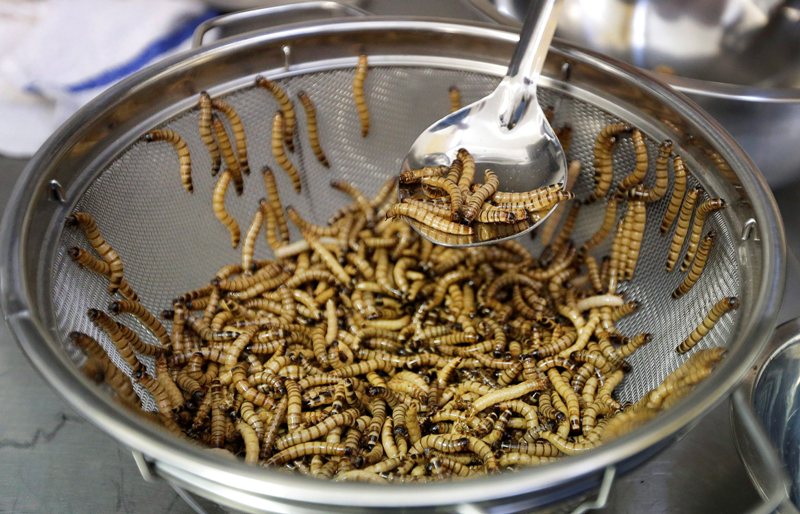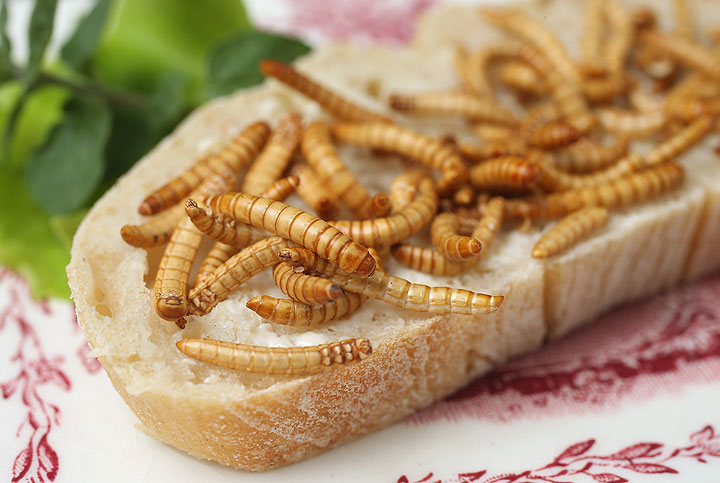WATCH ABOVE: Farming insects for food may be the solution to global hunger and an Ontario farm, raising crickets for food, is leading the way. Mike Drolet serves up the story.

TORONTO – For three brothers from a small Ontario town they never thought their future would be in farming insects.
Darren Goldin and his two brothers, Jarrod and Ryan, are the founders of Next Millennium Farms, tucked away in Campbellford, Ont., about two hours northeast of Toronto, and is the largest North American farm that breeds, raises and processes insects for human consumption.
“I never thought I would be a bug farmer,” Darren Goldin, told Global News. “I mean I was always one of those kids that loved animals and wildlife and spent a lot of time outdoors, but I never saw a future as a bug farmer.”
Opened in March of 2014, the farm is at the forefront of a new agriculture industry. Rather than pens filled with cows, chickens or pigs, the sibling-run operation is buzzing with the sounds of millions of crickets.
WATCH: A look inside North America’s largest cricket farm.
Goldin says although some people might be squeamish at the idea of eating creepy crawlies the business of farming insects, like crickets, is poised to explode as more people embrace the idea of eating them for both health and environmental reasons.
“We have been experiencing fairly rapid growth which is really exciting for us,” said Goldin. “We will be opening up about 20,000 sq. ft. of farming operations each month for the next three months. For us it will create about 20 to 23 new jobs over the summer.”
READ MORE: From tarantula tempura to cricket skewers, Insects could be coming to a menu near you
Entomophagy, the practice of eating insects, is not a new phenomenon as 80 per cent of the world’s countries eat bugs, according to the United Nations. The practice could increase as the world’s food production will need to increase by 70 per cent in 2050 to meet the world’s rising population, according to a 2013 report by United Nations Food and Agricultural Organization (FAO).
Crickets require 12 times less feed and 13 times less water than cattle to produce the same amount of edible protein, and not nearly as much farmable land.
Goldin says their main product, cricket flour, is a versatile product that can be used in almost anything.
“Whether it’s cookies, or a salad dressing, or vegetarian chili you can add small amounts of the cricket powder,” he said, which will add the extra protein and amino acids found in the cricket.
WATCH: Vij’s restaurant co-owner talks about putting crickets on the menu for the first time
One Canadian restaurant that’s experimented with using insects in their dishes is the well-known Vij’s Indian restaurant located in Vancouver, B.C.
Meeru Dhalwala, chef and co-owner with husband Vikram Vij, first put bugs on the menu in 2008 by grinding roasted crickets into flour and making paratha, an Indian flatbread.
“It was a delicious dish. But I would say that the crickets, when we served them in 2008, they created a much bigger talking buzz than people ordering them,” Dhalwala told Global News.
Dhalwala said while there was a lot of hype around the dish they would sell less than 10 dishes a night.
Her second foray into cooking with crickets involved one of the world’s most loved foods, pizza.
“The first time I introduced the crickets they were ground up so people couldn’t see them,” she said. “Now let me introduce them whole, but let me introduce them in the easiest way possible that people eat food.”
IN PHOTOS: A look at some examples of edible insects
The idea for the cricket naan pizza was then soon featured in 2010 at Rangoli, also owned by Dhalwala and her husband. However, the Vancouver chef said the cricket pizza was not a best seller and was removed after a year and even led to one complaint to the Vancouver health department.
Dhalwala said if insects are going to become a common cooking ingredient in North American kitchens chefs are going to have to work at making them taste as good as steak.
“If you are going to introduce a drastic new food item you have to do it with a lot of dignity and you better make sure it tastes good,” she said.
- What is a halal mortgage? How interest-free home financing works in Canada
- Capital gains changes are ‘really fair,’ Freeland says, as doctors cry foul
- Ontario doctors offer solutions to help address shortage of family physicians
- ‘Dangerous message’: Experts slam anti-sunscreen claims circulating online
In Texas, Robert Nathan Allen of Little Herds, a non-profit dedicated to bringing edible insects to market, says that it will take innovative chefs to bring entomophagy into the main stream.
Allen, who actually supplied Vij’s restaurant with their crickets, says there will need to be both an increase in educating the public on entomophagy and more farms, like Next Millennium, will need to open to keep up with demand.
Back in Ontario, Goldin says Next Millennium can’t keep up with demand from customers. Their largest customer is Exo, one of the biggest U.S. cricket protein bar manufacturers, and even sell their own t-shirts with the slogan “crickets are the new kale.”
*With files from Mike Drolet


















Comments